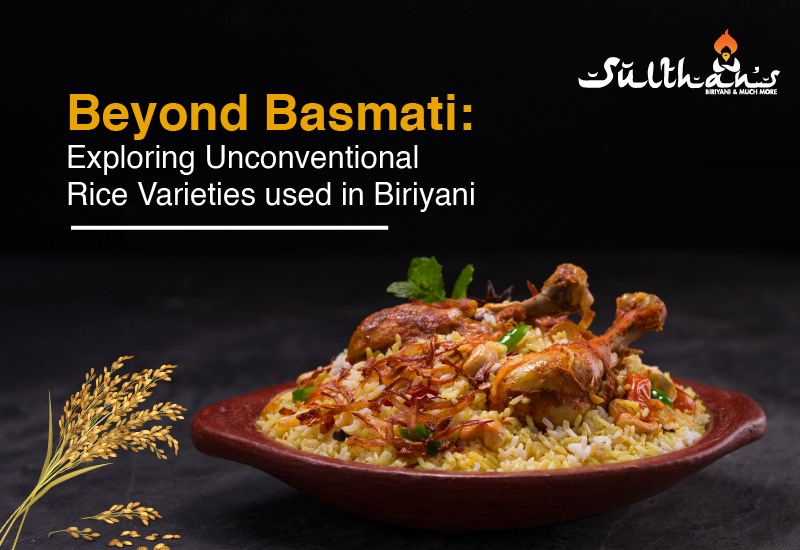Introduction
A popular and well-known dish, biryani is treasured in the mouths and hearts of foodies everywhere. Biryani, which is renowned for its flavourful mixture of spices and tender meats, has long been associated with Basmati rice, which is highly valued for both its aroma and consistency.
We explore the rich tapestry of unusual rice kinds in this investigation, going beyond the ordinary, with the potential to take the dish’s popularity to new heights. Prepare yourself for an unconventional culinary adventure as we reveal how lesser-known rice kinds can redefine the essence of this beloved dish.
Basmati Rice in Biryani: A Classic Choice
Hailed as the pinnacle of aromatic grains, basmati rice is a staple in biryani, a traditional and ageless option. Its unique long grains and scent add a pleasant texture and perfume to the Biryani experience.
Beyond its appearance, basmati has a strong cultural and historical importance that is ingrained in customary cooking methods. Its iconic reputation has been cemented by its inclusion in festive events and regal feasts.
Biryani lovers value Basmati’s contribution to the creation of delicious recipes such as Hyderabadi and Lucknawi Biryani. These recipes highlight the rice’s taste-absorbing prowess, resulting in a long-lasting, harmonious symphony of flavour and scent.
The Need for Diversity: Unconventional Rice Varieties

These special grains are shaped in large part by climate and geography, which affects their flavours and textures. In addition to encouraging interest in lesser-known rice varieties, the necessity for sustainable agricultural techniques also encourages diversification in rice growing.
A growing number of home cooks, chefs, and food aficionados are drawn to experimenting in the search for new flavours and textures that will elevate classic recipes.
This gastronomic journey corresponds with evolving tastes and inclinations, promoting a more comprehensive understanding of the wide range of rice alternatives accessible.
It signifies a change in perspective toward a more inclusive and varied approach to choosing rice, appreciating the great diversity of international culinary traditions while also understanding the impact on the environment.
Unveiling Unconventional Rice Varieties
Indian biryanis showcase a diverse range of rice varieties, each chosen to complement the flavours and textures of the dish. While Basmati rice remains a classic choice, various regional biryanis feature distinct rice varieties. Here are some notable examples:
1. Basmati Rice
Region: North India, particularly in recipes like Hyderabadi Biryani and Lucknawi Biryani.
Characteristics: Long-grain, fragrant, and fluffy, Basmati rice is renowned for its aromatic qualities.
2. Seeraga Samba Rice
Region: South India, notably in Chettinad Biryani.
Characteristics: Small, aromatic grains that contribute to a unique texture and fragrance.
3. Jeerakasala Rice
Region: Kerala, used in Malabar Biryani.
Characteristics: Short-grain rice with a distinct aroma, often known as “Kaima” rice.
4. Gobindobhog Rice
Region: West Bengal, featured in Kolkata Biryani.
Characteristics: Short-grain rice with a slightly sweet flavour, enhancing the biryani experience.
5. Ambemohar Rice
Region: Maharashtra, which is found in dishes like Kolhapuri Biryani.
Characteristics: Fragrant and short-grain rice, known for its unique aroma and taste.
6. Kala Namak Rice
Region: Northern India, used in Kashmiri Biryani.
Characteristics: Short-grain rice with a dark colour, imparting a hearty and robust flavour.
7. Sona Masuri Rice
Region: South India, featured in Andhra Biryani.
Characteristics: Medium-grain rice with a light texture, often preferred for its ability to absorb flavours.
8. Bhut Jolokia Rice
Region: Assam, used in Assamese Biryani.
Characteristics: Infused with the heat of the ghost pepper, adding a spicy kick to the biryani.
Because of these many rice types, Indian biryanis are richer both geographically and culturally, and each variation offers a distinctive and delectable taste experience.
Culinary Adventures: Biryani Recipes with Unconventional Rice

Adjust water ratios and cooking times based on the unique characteristics of the chosen grain. Incorporate traditional cooking techniques such as soaking and layering to ensure optimal texture and flavour absorption. Enjoy the variety that turns your Biryani into a culinary feast, whether it’s the nuttiness of Red Rice, the chewiness of Black Rice, or the fire from Bhut Jolokia Rice.
Modify the amount of spice, cooking durations, and layering methods according to the unique qualities of the selected rice. Try varying the complementing components to improve the overall balance of flavours. Accept the versatility that different rice types provide, letting your imagination run wild and producing a creative and tasty biryani.
Exploring Regional Variations
Different types of rice determine what the essence of a place’s food is. For aromatic long-grain elegance, biryanis from North India are primarily made using basmati rice.
Seeraga samba is preferred by its peers in the South for its unique texture. Local ingredients and spices tell distinctive stories; Kerala’s Thalassery Biryani exalts the richness of coconut milk, while Kashmir’s Biryani sings with saffron.
Variations in biryani are shaped by cultural differences; for example, Kolkata’s Biryani has a subtle sweetness, while Lucknow’s Awadhi biryani is a specialty reflecting refined Mughlai influence.
Every modification reflects the topography, temperature, and gastronomic legacy, weaving a delicious tapestry of rice-based treats that cut over national boundaries and honour the vast diversity of Indian cuisine.
From Farm to Fork: Sourcing Unconventional Rice
In addition to encouraging sustainable practices and protecting biodiversity, supporting regional farmers is also essential. Due to the possibility of certain types not being widely available, challenges for home cooks include limited accessibility and availability.
However, this disparity offers a chance for awareness-raising and education, motivating customers to seek and investigate a variety of rice options. Through the promotion of sustainable farming practices and the empowerment of regional farmers, these obstacles can become opportunities to improve nutritional diversity, elevate culinary customs, and support environmental preservation.
In order to create a more inclusive and sustainable approach to rice procurement, it is imperative to bridge the gap that exists between unconventional rice growers and consumers.
The Future of Biryani: Embracing Diversity
In the always-evolving world of global flavours influencing cuisine, expanding the variety of rice options for biryani creates a doorway to a world of inventive and creative possibilities. Using a variety of rice cultivars results in distinctive flavours, textures, and nutritional advantages. This variety promotes a complex tapestry of culinary influences and is in line with the changing desires of a worldwide audience.
In the kitchen, fostering experimentation ignites creativity and results in fusion Biryani recipes that slickly combine cultural traditions. It also encourages a wider range of rice cultivars, which advances sustainable agriculture.
Biryani provides a platform for cross-cultural culinary discussion as home cooks and chefs experiment with unusual rice options, highlighting the diversity of global gastronomy and influencing the dynamic growth of this cherished dish.
Sulthans Biryani

Sultan’s Biryani, which is well-known for its aromatic basmati rice, aromatic spices, and tender meat, perfectly captures the spirit of traditional biryani craftsmanship.
Each dish is a symphony of expertly blended spices, bringing the regal taste of biryani to aficionados with a dedication to authenticity. Sultan’s Biryani offers a royal culinary experience that honors the enduring history of this famous meal, inviting guests to enjoy the ideal balance of textures and scents.
Conclusion
By going beyond basmati rice in biryani, we discover a universe of gastronomic possibilities where different types of rice give this beloved dish new dimensions. Urging readers to try other grains will lead them on a fascinating trip that will turn biryani into a canvas of inventive tastes and worldwide influences. Although the fragrant appeal of basmati is still recognisable, the beauty is in the wide range of choices.
In addition to giving our experiences with biryani more depth, including unusual rice kinds, it highlights the changing character of gastronomy as we celebrate the growth of culinary traditions. Accept this inclusive and diversified approach since every grain has a distinct tale to tell, enhancing our taste buds and paying tribute to the ever-growing tradition of biryani.
FAQs
- What are the different types of rice used in biryani?
Different kinds of rice are used in the renowned South Asian meal called biryani. A popular option is basmati, which is renowned for its long grains and fragrant aroma. Additional types are the parboiled rice Sella and the aromatic short-grain rice Jeerakasala. The texture and flavor of biryani are influenced by the type of rice.
- Which rice is used in Hyderabadi biryani?
Basmati rice, which has large grains and a strong scent, is typically used to make Hyderabadi Biryani. The texture and flavor of the biryani are enhanced by this premium rice. Choosing Basmati rice is essential to getting the genuine flavor and texture of Hyderabadi Biryani.
- Which quality rice is best for biryani?
Basmati rice usually works best for biryani. The distinct and genuine taste of biryani is enhanced by its fluffy texture, lengthy grains, and aromatic scent. Because of its superior quality, basmati rice is a popular option for a wide range of biryani dishes from diverse culinary traditions.
- Can kolam rice be used for biryani?
Short-grain rice called kolam is not typically used for biryani. Because of their unique texture and scent, long-grain rice varieties like Basmati are usually used in recipes for biryani. Because of its softer and stickier texture, kolam rice can give biryani a distinct texture, which can detract from its overall attractiveness. For a true biryani experience, it’s advised to stay with classic options like Basmati.




